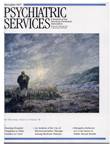An Agency-Based Representative Payee Program and Improved Community Tenure of Persons With Mental Illness
Abstract
OBJECTIVE: Representative payee programs help severely mentally ill individuals manage money from their Social Security payments to cover expenses for necessities and to avoid homelessness and rehospitalization. This study examined a representative payee program operated by a community mental health center to determine the criteria used by clinicians and case managers to refer clients to the program and to learn whether participation in the program was associated with reductions in hospitalization. METHODS: The retrospective study included 56 individuals with severe mental illness who were enrolled in the representative payee program at Community Counseling Centers of Chicago for one year and who also had received services from the agency for at least one year before enrollment. Criteria used to refer clients to the representative payee program were determined through chart reviews. Data on state hospitalizations before and after enrollment were available for the entire sample; additional data on Medicaid-funded private hospitalizations were available for a subset of 33 clients. RESULTS: The most common criteria for enrollment in the representative payee program were comorbid substance abuse or dependence (49 percent), a history of homelessness (33 percent), and frequent hospitalizations (32 percent). During the year of participation in the representative payee program, the mean number of days spent in state hospitals decreased markedly compared with the year before enrollment, from 68 days to seven days. A similar reduction was noted in the number of days spent in state and private hospitals, from 97 days to 15 days. CONCLUSIONS: Findings from this pre- and postintervention retrospective study are tentative in the absence of a more rigorous design. However, the results suggest that the representative payee program is quite effective in reducing hospital stays.



